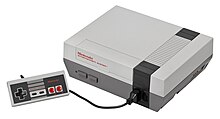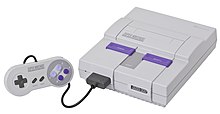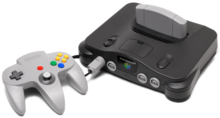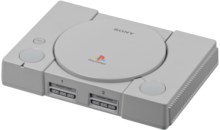Digital Media Concepts/Evolution of "Bits" in Game Graphics
In gaming graphics, the value of “bits” refers to the data width of the computing system. It is a classifier of processers, especially from the early era of games, when the amount of bits a device could handle was relatively low. Each bit represents a binary digit, allowing a corresponding number of different binary values to be represented visually[1].
8-Bit
[edit | edit source]For games and consoles utilizing 8-bit graphics, there was an allowance of 256 colored tiles (pixels) to portray graphics, with 64 maximum colors; however, there was a limit to how many different colors could be shown at once[2]. While games with lower bit computation, such as 4-bit and even 1-bit certainly do exist, they were not as popularized, nor were they classifiable as any specific genre as 8-bit is.
The 8-Bit Era
[edit | edit source]The third generation of video game consoles (1983–1990) is often referred to as the 8-bit era for the rise in consoles utilizing 8-bit processors[3]. Though prior games had explored other variations of bits lower than eight, the consistent releases of games on consoles supporting an 8-bit computing system categorize this time period as its own. Multiple new consoles were released, especially with the growing demand for home consoles rather than game machines at arcades.

This era was predominantly dominated by the Nintendo Entertainment System (NES), otherwise known as the Famicom (Family Computer). The console was released in Japan on July 15, 1983[4]. While the console’s release in North America in 1985 was initially met with skepticism, the console rose in popularity and eventually became the best-selling console for this generation. It made use of cartridges to support its games, which has become a staple in gaming, especially in that era of home gaming systems where any way to save computing power was appreciated. By doing this, the Famicom could use its higher procesing power and memory capabilities to support 8-bit games, making the graphics a much higher quality than its predecessors[3]. The Famicom is what projected Nintendo into popularity as a whole, allowing it to become the prominent game console company that it is today.

The Sega Master System (SMS) from Sega was released in 1985 in Japan, being released in North America, Europe, and Brazil in the following years. Being released after the Famicom, it boasted higher quality graphics as its systems had larger main and video RAM capabilities[3]. This means that, while the SMS also utilized the same 8-bit graphic prowess as the Famicom, it had higher processing abilities and was able to portray a broader range of colors than the Famicom—64 versus the Famicom’s 56—leaving a more vibrant and diverse look to the graphics of its games, especially with its utilization of a background layer, where static planes are independently displayed in terms of perspective compared to the foreground, producing a scrolling effect[5].

In addition to those systems is another notable console from this era, the Atari 7800 ProSystem. Again making use of 8-bit processors, the Atari 7800 was released in 1986 by Atari Corporation in order to share the spotlight of Nintendo’s Famicom. While the console would not be able to outshine the Famicom, it was a significant milestone in the development of game graphics for its ability to move numerous objects simultaneously while other consoles could not[3]. This increase in graphics quality is especially noteworthy when viewing the ported versions of various arcade games, which made the visuals from arcade classics such as Burger Time and Ms. Pac-Man much more pleasant. While the company’s previous console, the Atari 5200, made use of 8-bit graphics as well, the company would only see popularity in its release of the 7800, with improved controllers and its solutions to the 5200’s shortcomings[6].
| Game | Console |
|---|---|
| The Legend of Zelda | Nintendo Entertainment System |
| Super Mario Bros | Nintendo Entertainment System |
| Sonic the Hedgehog | Sega Master System |
| Centipede | Atari 7800 |
16-Bit:
[edit | edit source]Following the 8-bit era was the development and implementation of 16-bit game graphics. In comparison to 8-bit systems in game graphics, a 16-bit system had vastly increased processing power and the ability to represent more and a wider variety of values. This includes the number of pixels available to be shown, the different colors able to be portrayed, and the general memory and computing power of each system[7].
The Fourth Generation of Video Game Consoles
[edit | edit source]16-bit games were prominent during the fourth generation of gaming consoles from 1988-1999[8]. This increase in graphics led to a sharp increase in the success of various consoles and devices, especially from the previously mentioned companies of Sega and Nintendo, which established their presence in the industry with their aforementioned consoles.

Six years after the release of the Famicom, Nintendo released their Super Nintendo Entertainment System. It not only held a resolution double that of the Famicom but also wielded a palette with much more variety, being able to hold 256 color palette entries with their CGRAM (Color Graphics RAM). In addition to its ability to handle and maintain up to four graphics planes—layers in which the environment and sprites can be separated by features such as foreground and background and scrolled independently—the SNES had a vastly improved graphic quality due to Nintendo’s decision to move to a 16-bit system[9]. Additionally, its coprocessor, named Super FX, enabled 3D rendering, allowing for a more realistic and high-quality rendering of games[8].

Set off by the “console wars” between Nintendo and Sega due to the release of the former’s SNES, Sega released their first 16-bit console in Japan on October 29, 1988, the Sega Genesis. One thing that must be noted about the Sega Genesis is that while the console’s CPU (central processing unit) can be classified as either 16 or 32-bit, most aspects of the console’s system are applicable to 16-bit graphics[8]. This improved computing prowess led to a sharp increase in the quality of Sega’s console compared to the SNES.
| Game | Console |
|---|---|
| Star Fox | Super Nintendo Entertainment System |
| Donkey Kong Country | Super Nintendo Entertainment System |
| Mortal Combat | Sega Genesis |
| NBA Jam | Sega Genesis |
32 and 62-Bit:
[edit | edit source]Shortly after the development of 16-bit consoles, many developers worked on 32-bit processors, which quickly turned into 64-bit ones, following the pattern of doubling the previous amount of bits. For 32-bit systems, it typically can access around 4 GB of RAM or more, while a 64-bit system can access anything greater than 4 GB[10].
The Fifth Generation of Video Game Consoles
[edit | edit source]With this improvement in game graphics to both 32 and 64 bits, the fifth generation of video game consoles (1993–2001) was dominated by games with 3D graphics, a feat only possible due to the increased bits allowing for 3D polygon graphics and higher resolutions. In the previous generation, 3D graphics typically pertained to the background or simple sprites[11]. As such, this era also marks the transition from bit graphics to polygon graphics, making it the last era marked by bit capacity.

Nintendo released the Nintendo 64 in 1996, a home console with 64-bit graphics; however, the console supported both 32-bit and 64-bit modes of operation in order to support different games and extensions. It also introduced a feature called Z-buffering, which was an extra buffer that contained the depth (Z-value) of the nearest pixel with respect to the camera, which solved the previous consoles’ problems regarding the visibility of surfaces[12]. This is one of many of the system’s features that was only allowed due to the increased memory capacity and computing capabilities of a 64-bit processor, leading to the furthering of 3D graphics in games released for this console.

Sony released their first ever PlayStation in 1994, which ended up competing with the Nintendo 64. One key difference between the Sony PlayStation and Nintendo 64 is the former’s compatibility with running games via CDs rather than cartridges, which allowed for higher storage capabilities and, therefore, had superior graphics, despite being a 32-bit console [11]. Because of the upgrade to a 32-bit processor, the PlayStation utilized a Geometry Transformation Engine (GTE), which was a special processor that accelerated vector and matrix calculations, allowing for the proper rendering of 3D graphics, especially in combination with its GPU that had only a single frame buffer to rasterize graphics, or turn the geometry received into visual pixels. Additionally, the GPU of the PlayStation was also able to provide two shading algorithms: flat shading (consistent lighting levels) and Gouraud shading (individual lighting levels), which was more realistic[13].
| Game | Console |
|---|---|
| Super Smash Bros | Nintendo 64 |
| The Legend of Zelda: Ocarina of Time | Nintendo 64 |
| Tekken | Sony PlayStation |
| Metal Gear Solid | Sony PlayStation |
Computer Games:
[edit | edit source]Aside from consoles, computers during this era began to grow in popularity in reference to gaming. Before, computers were typically used for formal applications and other forms of entertainment while actually games were reserved for consoles, which were specifically designed for that form of media. Outside of consoles, most computers developed throughout the 1990s to early 2000s were made to support a 32-bit system, while most modern computers run a 64-bit system or higher[10]. Additionally, while 32-bit computers were created and utilized as early as the 1980s, there was little implementation of games to these devices due to many game development companies focusing on creation for console adaptation[14]. Some popular 32 and 64-bit computer games include Counter-Strike (32-bit), Papers, Please (32-bit), and Baldur's Gate 3 (64-bit)[15].
Legacy:
[edit | edit source]Due to the exponential growth in bits after the development of 64-bit systems, most increased graphics following are not labeled by their bit capacity. Now, most games are technically classified as 256-bit, but most lower-end computers run on 128-bit processors, and many consoles utilize a 512-bit system[16]. Nowadays, graphics improve on a more subtle scale, especially since there is little to no improvement to be made to the scale and tile dimensions of a game, which was one of the primary worries in evolving bit capacities.
Pixel Art/Retro Stylization
[edit | edit source]Since most modern games run on a 128-bit or more system, there is little pixelization in graphics, meaning that most game graphics’ pixels are practically invisible due to smooth rendering. Despite this, many developers and gamers are nostalgic for old games of the 8-bit style, leading to the revitalization of pixel art graphics.
Many modern games utilize a pixel art style, where they limit themselves to a certain amount of pixels (tiles) on the screen, as was the norm with 8-bit games, despite running on systems with much higher amounts of bits. Of course, oftentimes, these sorts of games do not limit themselves with colors and computerization but do their best to instill that sense of nostalgia for 8-bit games in their own modern ones[17]. This includes games of many cult favorites such as Terraria, Shovel Knight, and Undertale, which each make unique utilizations of the pixel art style.
References
[edit | edit source]- ↑ Lenovo. "What is 8-bit? An Overview of 8-bit Technology | Lenovo US". www.lenovo.com. Retrieved 2024-03-24.
- ↑ Paez, Danny (2020-10-25). "How a beloved video game style was spawned out of necessity". Inverse. Retrieved 2024-03-24.
- ↑ 3.0 3.1 3.2 3.3 Waldron, Valerie. "CVGA Disassembled | Third Generation (1983-1990) · Online Exhibits". apps.lib.umich.edu. Retrieved 2024-03-24.
- ↑ Britannica, The Editors of Encyclopedia. (2024-01-04). "Nintendo Console". Britannica. Retrieved 2024-03-24.
- ↑ Retro, Sega (2023-02-23). "Sega Master System/Technical specifications". Sega Retro. Retrieved 2024-03-24.
- ↑ RetroPete. "Atari 7800 had great graphics & brought new life to the VCS game library | 2600 + 5200 = 7800". 8-Bit Central. Retrieved 2024-03-24.
- ↑ Lenovo. "Compare 8- vs 16-bit Systems & Common Applications | Lenovo US". www.lenovo.com. Retrieved 2024-03-24.
- ↑ 8.0 8.1 8.2 Waldron, Valerie. "CVGA Disassembled | Fourth Generation (1988-1999) · Online Exhibits". apps.lib.umich.edu. Retrieved 2024-03-24.
- ↑ Meow, Write (2017-11-08). "Super Nintendo Graphics Guide". Mega Cat Studios, Inc. Retrieved 2024-03-24.
- ↑ 10.0 10.1 "Difference Between 32-bit and 64-bit Operating Systems". GeeksforGeeks. 2017-11-16. Retrieved 2024-03-24.
- ↑ 11.0 11.1 Waldron, Valerie. "CVGA Disassembled | Fifth Generation (1993-2001) · Online Exhibits". apps.lib.umich.edu. Retrieved 2024-03-24.
- ↑ Copetti, Rodrigo (2019-09-12). "Nintendo 64 Architecture | A Practical Analysis". The Copetti site. Retrieved 2024-03-24.
- ↑ Copetti, Rodrigo (2019-09-12). "PlayStation Architecture | A Practical Analysis". The Copetti site. Retrieved 2024-03-24.
- ↑ "Definition of 32-bit computing". PCMAG. Retrieved 2024-03-25.
- ↑ "List of Windows 64-bit games - PCGamingWiki PCGW - bugs, fixes, crashes, mods, guides and improvements for every PC game". www.pcgamingwiki.com. Retrieved 2024-03-25.
- ↑ Perrin, Steve (2022-05-31). "Whatever Happened To Bits In Gaming?". Little Bits of Gaming & Movies. Retrieved 2024-03-24.
- ↑ "Pixel Art/8 bit Graphics-Style Use in Modern Games - Rising Trends". Logicsimplified. 2017-09-08. Retrieved 2024-03-24.
